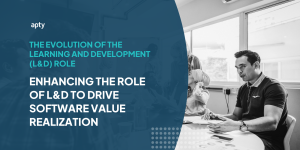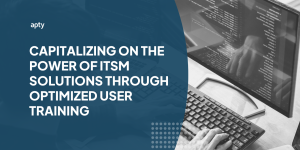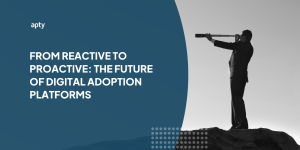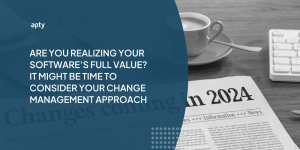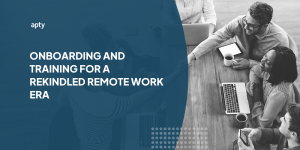It’s finally time. After months of implementation, customization and in-depth user training sessions across departments, it’s go-live day for your new enterprise software. “This system is going to save us so much time and money,” many change management leaders think. “What could possibly go wrong?”
Unfortunately, quite a lot. Let’s look at ERP implementations as a case in point – according to Gartner, 55 – 75 percent of ERP projects either fail or don’t meet their intended objectives. There are several reasons for this, but a big one has to do with insufficient training and support (change management).
People are naturally wired to resist change. It is therefore not surprising that many employees’ responses to digital transformation follow a process similar to the Kubler-Ross Stages of Grief, which, in the context of software adoption, we can think of as the related Kubler-Ross Change Curve. Faced with unfamiliar software, people instinctively become entrenched – reacting initially with shock and denial, leading to frustration and depression (and a corresponding sharp decline in productivity) before slowly giving way to acceptance and integration of the new tool into their work lives.
But sometimes, employees don’t make it to the acceptance and integration phase. They get what we call “stuck in the mud.” And by the time the organization realizes this, it’s usually too late, because employees have found workarounds and abandoned the software altogether.
The key to realizing software’s full value is a more modern approach including the following:
A superior user experience
Traditional training methods like emails, videos, and quick reference guides fail for several reasons. First, they are quickly outdated over time, especially given the increased reliance on cloud apps featuring frequent releases throughout the year. Today, organizations worldwide are using an average of 130 cloud-based SaaS applications, which are updated more frequently than traditional software, in many cases on a weekly or monthly basis. Users go through a significant amount of change to stay up to date on new features, which can result in a huge hit to productivity for both business users and IT as users request help to get up to speed.

In addition, and perhaps more importantly – a new breed of users has arrived, one that doesn’t want this type of training. Empowered by unbelievably slick and reliable online services, like Google and social media, as well as their mobile devices, today’s consumers are used to getting exactly what they want, when they want it, instantly and effortlessly. This makes them more curious – but also more impatient and demanding. That is why corporate users want to be intuitively guided through software just as they are with their favorite consumer app experiences. When the user experience falls short, it is then that employees are most apt to give up on an application. This is very similar to the world of e-commerce, where as little as a one-second delay in response time has been known to lead to considerable site abandonment.
On the other hand, guiding users through software step-by-step in their moment of need can be the key to greater adoption. The real-time delivery of content makes the learning process intuitive and seamless and helps account for the “forgetting curve,” or the reality that most people forget newly learned information in a week – an inherent shortcoming of most one-time, standalone training approaches.
Easy Identification and Remediation of Problem Areas
Traditionally, change management teams have required executive buy-in on remedial measures, but this approach is no longer sufficient, given the pace and frequency of software updates and corresponding training initiatives. Rather, change management teams need to be able to identify where problems are and quickly fix them through targeted content delivery (for example, reminders, alerts, banners, and information bubbles), addressing specific pain points in software for various user segments.

By reducing or eliminating “learning friction” in this way, organizations can decrease or eliminate the depression phase and its associated productivity malaise, moving users more quickly into acceptance and integration. The time to onboarding new users becomes much shorter, shrinking time to software value.
Proof of Software Adoption
Today’s CFOs and CTOs don’t want to be what Gartner calls a “growth anchor” – obstacles that place a drag on growth. Yet, they are under extreme pressure to defend their investments and prove ROI. And as we face an economic downturn, reduced budgets, and continual digital transformation, CFOs and CTOs are held to even higher standards. Without linked software value, they could be left potentially holding tens of millions of dollars in cost with no ROI to show for it. They require tangible and favorable results from enterprise investments faster to positively drive the bottom line and avoid becoming a growth anchor.
It is clear that an organization can’t improve what it can’t measure. Today, companies are spending millions on new software, and in today’s profit-centered mandates, they can no longer afford to just “guess” or hope what the ROI might be and assume value is being realized. Across various departments, there needs to be activity tracking and analytics to deliver insights on whether and which users are embracing the software.

Despite the clear advantages that a new technology may present to users in terms of enhancing communication and collaboration within the organization, left to their own devices, many employees will just downright refuse to use it. The importance of overcoming this roadblock cannot be overstated, as studies have found that digitally mature companies are significantly more profitable than their less digitally mature counterparts. This is where digital adoption platforms (DAPs) can come in handy, providing application users with in-app guidance and real-time support, ultimately helping drive adoption.
The truth is, meaningful software and process adoption cannot be achieved through change management consisting of one-time, static communications and/or training sessions alone. Organizations adhering to this outdated approach will likely have a dystopian experience with their enterprise software – a sense of frustration, inefficiency, and loss from seeing their employees getting mired in the quagmire of depression, apathy, and poor productivity. It is time that we realize that reaching an enterprise software “go-live” date is not the end of a marathon – instead, it’s only the beginning of an exciting journey that change management professionals need to adopt for the long haul.

